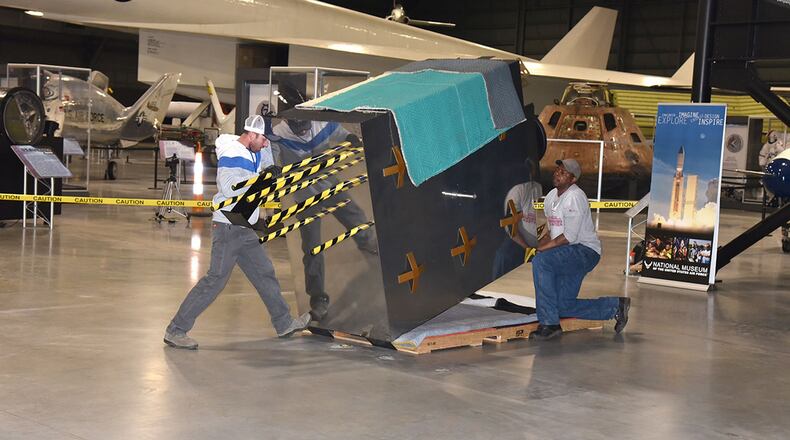How has the National Museum of the U.S. Air Force’s mission been conducted during the COVID-19 pandemic?
Tillotson: Among our biggest challenges has been how to maintain contact with potential future visitors at a time when in-person visits are not possible. One of the ways we did so was by expanding our digital museum experience through the virtual tour which allows visitors to take a 360-degree, self-guided tour of the entire museum.
Virtual visitors can access online educational activities, such as lesson plans, word searches, coloring sheets and other items that can be done at home, along with new videos, including first-hand accounts from veterans who served on missions from several different eras. The tour also offers virtual reality capabilities, using Google headsets, and social applications, such as the snapshot tool (camera icon), which allows for individuals to screen-grab the location they’re at and post to Facebook, Twitter, Instagram and other social media sites.
Because we do have government staffing, we also have maintained a schedule of continued updates to the museum in terms of new exhibits and gallery reorganizations.
What has the staff been doing? Have there been any changes to the collection?
Tillotson: The staff has been busy planning to allow the public to have an enjoyable visit while conforming to the new health guidelines. This has required restructuring the museum to allow the public to visit, while making sure that both staff and visitors are afforded an environment that minimizes the COVID-19 risk.
Despite being closed to the public, the staff was able to continue production and deployment of new exhibits planned for this year. A new exhibit on the global positioning system – the way your mapping tools on your phone and car work – is already on the floor.
A new exhibit on how we put satellites in geosynchronous orbit, the inertial upper stage booster, is also on the floor. Both are available to the public upon reopening.
Back in the Presidential Gallery, we are working on an enhanced display about the aircrews who fly the president. Opening in the August time frame, this engaging exhibit will ask and answer such questions as “What music did American presidents enjoy? and “Were there really jellybeans on the aircraft?”
The “Flying the President” exhibit will tell the story and display real artifacts from the aircrews and maintenance personnel who transported the president of the United States on fixed-wing aircraft around the world.
By November we will have in place a museum-wide update on women in the Air Force. Not only will we highlight individual women, but we will trace the changes in policy and law that have allowed a greater role for women in the armed forces. And again, there are some human-interest elements. For example, what does a fine arts major have to do with the Mercury space program?
Finally, we are also partnering with the International Association of Astronomical Artists on an exhibit called “The Beauty of Space,” which is scheduled to open in late summer. This temporary exhibit will offer visitors awe-inspiring art of varying mediums created by artists across the country. Given the first crewed space launch from the U.S. in nine years, we think two new space exhibits and an art exhibit will provide interest.
What can the public anticipate happening when the museum reopens? Are there any special procedures planned?
Tillotson: The most visible initial change visitors will encounter are the new procedures for entry and exit. We are in the process of modifying the building access plan so visitors will come in through one set of doors, and departure will be through a separate set of doors.
General access to the gallery floors will be largely unchanged – it’s a big space. However, some of our accessible aircraft, especially the presidential aircraft, initially will not be open for visitors to walk through. We are also considering how to modify or remove interactive displays for the near term.
While we do not plan to have timed entry, access to the attractions and retail operations will require that visitors consider when they would like to visit those amenities. Perhaps the most positive and permanent change visitors will encounter is we will now permit visitors to bring their own bottled water into the galleries.
For the Air Force Museum Foundation’s attractions (theater and simulator rides), café and retail, we expect all to be open with guidelines to limit the number of people and to ensure we can support cleaning between use.
Our safety measures will conform to CDC (Centers for Disease Control and Prevention) and Ohio guidelines. Staff members who interact with the public will be masked; check out and payment locations will have sneeze guards; and we will regularly sanitize high-traffic areas. Our cafeteria operation will be modified to support over-the-counter service rather than “grab and go,” and seating in the cafeteria will be limited.
Has there been any “upside” to the museum being closed? Has it ever been closed for this long before?
Tillotson: Besides having additional time to focus on the upcoming new exhibits previously mentioned, we also have used this time to plan ahead, and our experience with social media is causing us to continue to evolve how we interact with new audiences who have little familiarity with the Air Force, the Space Force or even the Department of Defense.
The museum was closed during World War II (and for several years later) as that space was needed for wartime purposes but eventually reopened to the public in a newly configured facility in 1954.
Is there a way to support the museum right now?
Tillotson: Visit the museum's website, take a virtual tour or connect with us via our social media pages.
Anything else, sir?
Tillotson: We are planning other activities as new guidelines are issued by the CDC and the state of Ohio, so stay tuned to our website: https://www.nationalmuseum.af.mil/.
About the Author
